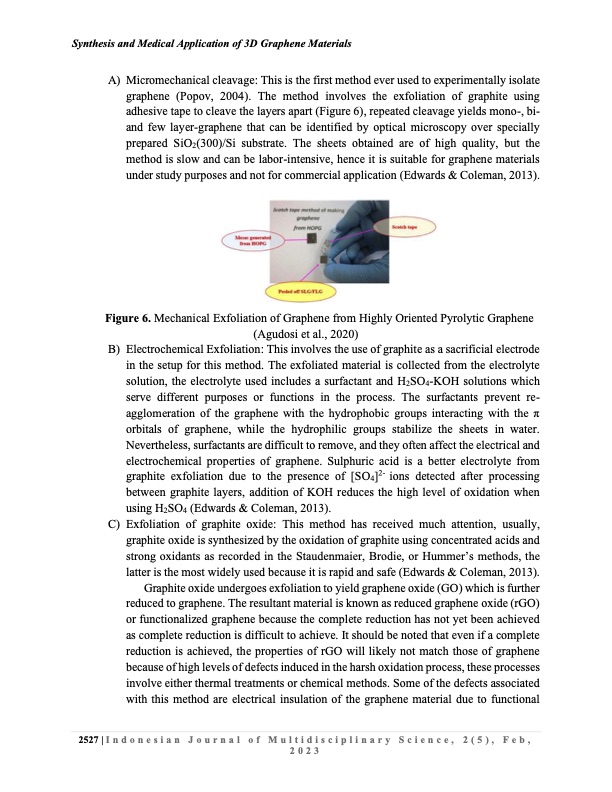
PDF Publication Title:
Text from PDF Page: 008
Synthesis and Medical Application of 3D Graphene Materials A) Micromechanical cleavage: This is the first method ever used to experimentally isolate graphene (Popov, 2004). The method involves the exfoliation of graphite using adhesive tape to cleave the layers apart (Figure 6), repeated cleavage yields mono-, bi- and few layer-graphene that can be identified by optical microscopy over specially prepared SiO2(300)/Si substrate. The sheets obtained are of high quality, but the method is slow and can be labor-intensive, hence it is suitable for graphene materials under study purposes and not for commercial application (Edwards & Coleman, 2013). Figure 6. Mechanical Exfoliation of Graphene from Highly Oriented Pyrolytic Graphene (Agudosi et al., 2020) B) Electrochemical Exfoliation: This involves the use of graphite as a sacrificial electrode in the setup for this method. The exfoliated material is collected from the electrolyte solution, the electrolyte used includes a surfactant and H2SO4-KOH solutions which serve different purposes or functions in the process. The surfactants prevent re- agglomeration of the graphene with the hydrophobic groups interacting with the π orbitals of graphene, while the hydrophilic groups stabilize the sheets in water. Nevertheless, surfactants are difficult to remove, and they often affect the electrical and electrochemical properties of graphene. Sulphuric acid is a better electrolyte from graphite exfoliation due to the presence of [SO4]2- ions detected after processing between graphite layers, addition of KOH reduces the high level of oxidation when using H2SO4 (Edwards & Coleman, 2013). C) Exfoliation of graphite oxide: This method has received much attention, usually, graphite oxide is synthesized by the oxidation of graphite using concentrated acids and strong oxidants as recorded in the Staudenmaier, Brodie, or Hummer’s methods, the latter is the most widely used because it is rapid and safe (Edwards & Coleman, 2013). Graphite oxide undergoes exfoliation to yield graphene oxide (GO) which is further reduced to graphene. The resultant material is known as reduced graphene oxide (rGO) or functionalized graphene because the complete reduction has not yet been achieved as complete reduction is difficult to achieve. It should be noted that even if a complete reduction is achieved, the properties of rGO will likely not match those of graphene because of high levels of defects induced in the harsh oxidation process, these processes involve either thermal treatments or chemical methods. Some of the defects associated with this method are electrical insulation of the graphene material due to functional 2527|Indonesian Journal of Multidisciplinary Science, 2(5), Feb, 2023PDF Image | Medical Application of 3D Graphene

PDF Search Title:
Medical Application of 3D GrapheneOriginal File Name Searched:
SYNTHESIS-MEDICAL-APP-3D-GRAPHENE.pdfDIY PDF Search: Google It | Yahoo | Bing
Salgenx Redox Flow Battery Technology: Power up your energy storage game with Salgenx Salt Water Battery. With its advanced technology, the flow battery provides reliable, scalable, and sustainable energy storage for utility-scale projects. Upgrade to a Salgenx flow battery today and take control of your energy future.
| CONTACT TEL: 608-238-6001 Email: greg@infinityturbine.com | RSS | AMP |